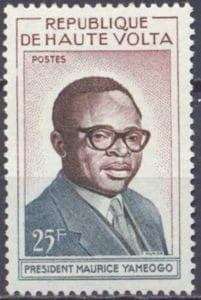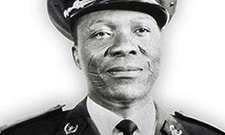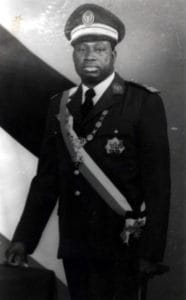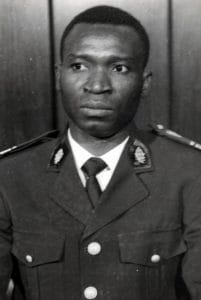1960-1987, an Unstable Country and its 6 Military Coups
Compaoré was about to become a teenager when Upper Volta – as the country was called under French dominion – became an independent state on August 5, 1960 (66). From 1960 until Compaoré’s arrival to power in 1987, the country endured 6 military coups and the establishment of 3 republics. The chaotic succession of authoritarian regimes only came to an end in 1987 (67).
Only once was a president appointed by elections over this entire period. Governance was nearly entirely carried out by political-military regimes: of the 5 young republic’s presidents, 4 belonged to the military. All of them were ousted from presidency by force and placed under house arrest, except for Captain Thomas Sankara who was killed during the coup on October 15, 1987 (68).
IMPORTANT DATES
- 1974, February 8 : 2nd putsch by President Sangoulé Lamizana
- 1977, November 30 : birth of the 3rd Republic
- 1978 : Compaoré engages with Marxism
- 1980, November 25 : 3rd putsch by Colonel Saye Zerbo
- 1982 : special elite training in commanding paratroopers in Pau (France)
1970-1980, military career and political awakening
 The authoritarian regime of the first President of the Republic Maurice Yaméogo provoked a national revolt. He was overthrown by street demonstrators on January 3, 1966. The army Chief of Staff Sangoulé Lamizana, supported by the Roman Catholic Church, took over from him in a bloodless coup, establishing a military regime (69).
The authoritarian regime of the first President of the Republic Maurice Yaméogo provoked a national revolt. He was overthrown by street demonstrators on January 3, 1966. The army Chief of Staff Sangoulé Lamizana, supported by the Roman Catholic Church, took over from him in a bloodless coup, establishing a military regime (69).
Heading student rights movements
In December 1970, several political parties participated in the country’s first real legislative elections (70). During this brief but intense period of fertile political life in Burkina, the young Blaise attended l’Ecole Normale de Ouagadougou (E.N.O.) in the capital where he led student rights movements on several occasions.
Enrollment by force in the Army
In 1971, after a student demonstration, Compaoré “l’enfant terrible de Ziniaré” was enrolled by force in the special contingent of the Army as a punishment. What was meant as a correction turned out to be a blessing for the young man who had always dreamed of becoming a soldier like his father. Very soon, Compaoré was appointed to guard the home of Sangoulé Lamizana, the Head of State of Burkina Faso (72).
1973-1976, Military training abroad
During the Second Republic, the pending presidential elections of 1975 brought about a political deadlock. On February 2, 1974, the trade unions asked the Head of State Sangoulé Lamizana “to end the untenable situation as soon as possible” (73). A military coup followed. On February 8, President Lamizana dissolved the National Assembly and the Government, and remilitarized the institutions (74).
At that time, Compaoré was abroad. In September 1973, he passed the entrance examination of the Inter-Army Military Academy of Cameroon (75). Several military trainings far from home followed: specialization at the Infantry School of Montpellier, commando instructor courses in Mont-Louis, Collioure, Briançon and in Montgenèvre (all in France) as well as in Münsingen (Germany), followed by training at the French airborne and instructor courses for paratroopers in Rabat (Morocco) in 1978 (76).
Twice in 1982, Captain Blaise Compaoré received special training as a paratrooper commander in Pau (France); the courses included free-falling techniques from an altitude of 3,000 meters and the strategic and logistic combat planning of 500 parachutists (77).
Compaoré and Communism
Outraged by social misery, rampant famines (78) and inadequate government programs in response to these challenges, Compaoré drew inspiration from communism. In this period, the world witnessed escalations of the Cold War in Third World countries: the Vietnam War, military coups in Chile, Uruguay and Argentina, as well as the Yom Kippur War and the Ogaden War in Africa.
Politically, it was also a tense period in Ouagadougou. Encouraged by a growing popular mobilization to defend the frontiers against the Malian « invasion », eventually escalating in a 3-day’s war between both countries, the army started to feel again and did not resist any longer the temptation to create on November 29,1975, the “only and unique” party le “Mouvement National pour le Renouveau” (MNR). But, the population reacted fiercely. Unions, political parties, religious leaders and similar organized general strike days, forcing president Lamizana to accept a return to a republican regime. On February 9, 1976, a transitional government was formed. And, on November 30, 1977, a new Constitution was adopted, giving birth to the Third Republic (79).
The permanent instability eventually benefited the extreme left, which had witnessed many years of Upper Volta’s political life (80) . The communist party “Parti Africain de l’Indépendance de Haute-Volta” was founded in 1963 (81). Forming an active minority in secondary schools and universities, the extreme left produced many political parties and powerful teachers’ trade unions like the SUVESS (Syndicat Unique Voltaïque de l’Enseignement Sécondaire et Supérieur) and the SNEAHV (Syndicat National des Enseignants Africains de Haute-Volta). A 56 days’ strike of the SNEAHV deteriorated the social climate and paralyzed the Third Republic (82).
Compaoré’s political engagement with Marxism was consolidated during the Third Republic. In May 1978, he was assigned to the Airborne Response Company of Bobo-Dioulasso (83). In 1980, he became the aide-de-camp to the Chief of Staff of the Army.
3rd Republic 1977-1980 followed by a 3rd military coup
With the Third Republic installed, running president Lamizana, leader of the UDV-RDA party, won the first round of the presidential elections with 41% on May 14, 1978. The former president Maurice Yaméogo, in exile in Côte d’Ivoire, also unofficially participated with his new party – created by his son – namely “l’Union Nationale pour la Défense de la Démocratie” (UNDD). Deprived of his civic and political rights, he was “represented” by Macaire Ouédraogo, a banker, and obtained 28% of the votes. Joseph Ki-Zerbo and his leftist party obtained 11% of the votes. 35% of registered voters cast ballots during the first round of the presidential election (84).
On May 28, 1978, during the second presidential round with a turnout of 44 % of registered voters, Lamizana confronted a united opposition and obtained a victory with 56% of the votes (85). No presidential election took place over the subsequent 13 years. The country waited until 1991 to hold its second presidential elections, with Compaoré’s arrival in power.
The Third Republic was not granted a long life either. The country’s habitual political turmoil soon reappeared as President Lamizana was unable to form a stable majority with which to govern, aggravating political tensions between government and opposition (86).
1980-1983, A permanent situation of coup d’état
Another coup – the third one – followed on November 25, 1980, putting an end to the Third Republic and giving way to a decade of political instability (87). It was staged by Colonel Saye Zerbo, President Lamizana’s former foreign minister from 1974-1978, and supported by leftist forces (88). Cardinal Paul Zoungrana, unhappy with Lamizana’s pro-Arab politics, called it “A coup coming from Heaven (89).
President Zerbo immediately installed his regime with firmness, abolishing both the right to strike and press freedom, whilst returning to the one-party system with the “Comité Militaire de Redressement pour le Progrès National” (CMRPN) (90). Blaise Compaoré and Thomas Sankara, young officers with ideas far more progressive than those of President Zerbo, also became members of the CMRPN. Sankara served briefly as the country’s Secretary of Information (91).
Compaoré was at that time heading the National Commando Training Center (CNEC) in Pô, located South-East of the country (92). During that period, Compaoré became one of the country’s leading officers and a key player in politics (93).
Compaoré resigns from the military committee (CMRPN)
Disappointed by the complete lack of vision of the CMRPN, Captain Blaise Compaoré sent President Zerbo his letter of resignation from the military committee, officially denouncing his badly planned and improvised policies. His companions Captain Henri Zongo and Captain Thomas Sankara did the same (94). Sankara resigned on April 12, 1982, making his action the focus of media attention. Henri Zongo had preceded him a mere week earlier, on April 8 (95).
IMPORTANT DATES
- 1982, March : President Saye Zerbo orders suppression of right to strike
- April 1 : Compaoré resigns from the CMRPN
- May 14 : Compaoré, Sankara and Zongo emprisoned
- November 7 : 4th putsch by the CPSP
- November 8 : Jean-Baptiste Ouédraogo, President of the CSP
Compaoré’s imprisonment
On May 14, 1982, Compaoré, Sankara and Zongo were imprisoned respectively in Bobo Dioulasso, Dédougou and Ouahigouya, for having distributed their letters of resignation at the barracks. They were released after three months but had lost their officer ranking (96). So did all those who had followed them. The creation of their legend within the army had started.
The November ’82 putsch
On November 7, 1982, another coup was carried out by elements of the fragmented military (97). Compaoré considered them as a bunch of adventurers and feared that in case their improvised coup failed he and his companions would have been accused of being part of the plot, hence facing harsh punishment. At the very last moment, Compaoré along with Sankara and Zongo decided to fully back the putsch in order to ensure its success.
That same night, with a tank and three men, Compaoré headed for President Zerbo’s home. The presidential guards abandoned the spot immediately. But, instead of entering, Compaoré waited until dawn before going to see Zerbo, asking the President to come along with him. Compaoré proposed that the group of putschists call themselves the “Conseil Provisoire du Salut du Peuple” (CPSP) (98). Intuiting that these mistrustful adventurous soldiers did not want his salvation, he decided to flee, jumping on a train to Bobo Dioulasso where he joined Sankara and Zongo (99). They installed military doctor Jean-Baptiste Ouédraogo as President and Head of the “Conseil du Salut du Peuple” (CSP), with Sankara as his Prime Minister (100).


